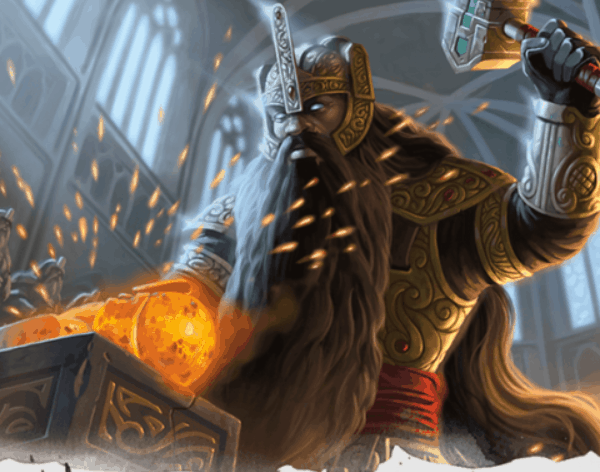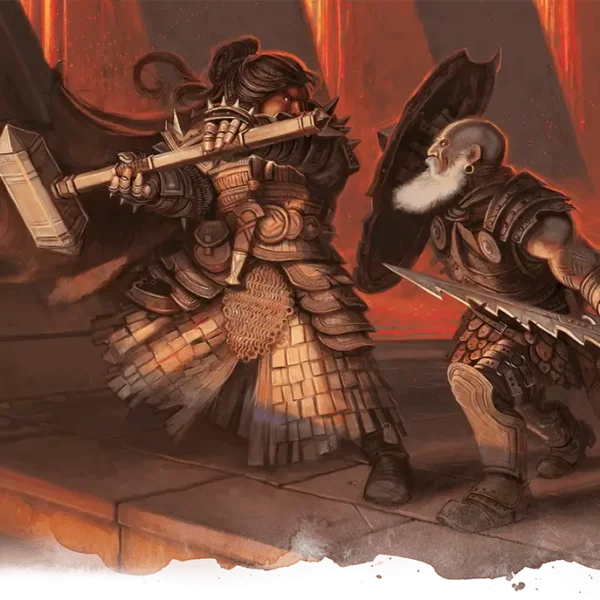Bard spells are often depicted as captivating entertainers who utilize their wit and charm to seduce and/or perplex others in their vicinity, occasionally with a dash of magic thrown in for good measure.
Bards have complete spellcasting advancement in D&D 5e, which means they may ultimately cast 9th-level spells—the highest tier of magic—in the game.
In battle and out, the Bard can use a variety of support and control spells to benefit and heal allies, disable enemies, and deal with a wide range of other circumstances.
Bards, in contrast to other classes like clerics, druids, and wizards, have a restricted number of spells from which to choose.
As a result, players must carefully analyze their spell selections, as they have a limited number of chances to learn new spells or change their options.
When it comes to Bards, I’ve found that focusing on utility and support spells with a little bit of damage is the most effective strategy for me. That being said, here is my selection of the finest spells! *
No cantrips will be included in this list because I’ll be focusing on spells that are at least 1st level.
- 25. Charm Monster
- 24. Catnap
- 23. Aid
- 22. Animal Friendship
- 21. Blade Ward
- 20. Psychic Scream
- 19. Enemies Abound
- 18. Teleport
- 17. Synaptic Static
- 16. Tasha’s Hideous Laughter
- 15. Sending
- 13. Otto’s Irresistible Dance
- 12. Dissonant Whispers
- 11. Hold Monster/Hold Person
- 10. True Polymorph
- 9. Suggestion/Mass Suggestion
- 8. Forcecage
- 7. Faerie Fire
- 6. Dimension Door
- 5. Hypnotic Pattern
- 4. Dominate Monster/Dominate Person
- 3. Healing Word
- 2. Invisibility/Greater Invisibility
- 1. Polymorph
25. Charm Monster
Source: Xanathar’s Guide to Everything
4th-level enchantment
Casting Time: 1 action
Range: 30 feet
Components: V, S
Duration: 1 hour
You attempt to charm a creature you can see within range. It must make a Wisdom saving throw, and it does so with advantage if you or your companions are fighting it.
If it fails the saving throw, it is charmed by you until the spell ends or until you or your companions do anything harmful to it.
The charmed creature is friendly to you. When the spell ends, the creature knows it was charmed by you.
At Higher Levels. When you cast this spell using a spell slot of 5th level or higher, you can target one additional creature for each slot level above 4th. The creatures must be within 30 feet of each other when you target them.
24. Catnap
Source: Xanathar’s Guide to Everything
3rd-level Enchantment
Casting Time: 1 action
Range: 30 feet
Components: S, M (a pinch of sand)
Duration: 10 minutes
You make a calming gesture, and up to three willing creatures of your choice that you can see within range fall unconscious for the spell’s duration.
The spell ends on a target early if it takes damage or someone uses an action to shake or slap it awake.
If a target remains unconscious for the full duration, that target gains the benefit of a short rest, and it can’t be affected by this spell again until it finishes a long rest.
23. Aid
Source: Player’s Handbook
2nd-level abjuration
Casting Time: 1 action
Range: 30 feet
Components: V, S, M (a tiny strip of white cloth)
Duration: 8 hours
Your spell bolsters your allies with toughness and resolve. Choose up to three creatures within range. Each target’s hit point maximum and current hit points increase by 5 for the duration.
At Higher Levels. When you cast this spell using a spell slot of 3rd level or higher, a target’s hit points increase by an additional 5 for each slot level above 2nd.
22. Animal Friendship
Source: Player’s Handbook
1st-level enchantment
Casting Time: 1 action
Range: 30 feet
Components: V, S, M (a morsel of food)
Duration: 24 hours
This spell lets you convince a beast that you mean it no harm. Choose a beast that you can see within range.
It must see and hear you. If the beast’s Intelligence is 4 or higher, the spell fails. Otherwise, the beast must succeed on a Wisdom saving throw or be charmed by you for the spell’s duration.
If you or one of your companions harms the target, the spell ends.
At Higher Levels. When you cast this spell using a spell slot of 2nd level or higher, you can affect one additional beast for each slot level above 1st.
21. Blade Ward
Source: Player’s Handbook
Casting Time: 1 action
Range: Self
Components: V, S
Duration: 1 round
You extend your hand and trace a sigil of warding in the air.
Until the end of your next turn, you have resistance against bludgeoning, piercing, and slashing damage dealt by weapon attacks.
20. Psychic Scream
Source: Xanathar’s Guide to Everything
Full spellcasting classes like the Bard have access to strong 9th-level spells in D&D.
There are a few I’d like to point out, but their utility for most Bards is limited by the time and effort required to reach the 9th level (17 levels in the class at the earliest), so their overall placement on this list is affected.
While the majority of animals lack formidable Intelligence saves, the scream can possibly shock up to 10 creatures of your choice within a 90-foot radius, making it more likely for them to fail the saving.
A spell of this magnitude has the potential to terminate a conflict before it has even begun.
19. Enemies Abound
Source: Xanathar’s Guide to Everything
During the battle, enemies abound and can turn a single creature into a wild card for a short period of time. This control option is available to bards.
The victim is unable to discern between their comrades and foes, so they must use their attacks or abilities to target anybody they choose.
In some situations, this spell may provide your team with a temporary advantage in terms of numbers.
This spell has a higher chance of working if you keep your focus on it because of the abundance of foes that require the less frequent Intelligence saving throw (since spellcasters can only have one concentration spell going at a time).
18. Teleport
Source: Player’s Handbook
Teleport is a 7th-level spell that accomplishes just what it says on the tin.
As many as eight willing targets (including objects) can be transported at the same time to any location on the same plane of existence.
Depending on how well-versed on the locale your Bard is, you may now be taking a chance.
If you’re looking to save time or get out of trouble, fast group teleportation is a terrific tool to have at your disposal.
17. Synaptic Static
Source: Xanathar’s Guide to Everything
Due to the dearth of excellent higher-level destructive options, Bard’s spell repertoire suffered.
Synaptic static, on the other hand, was able to fix this problem.
It is possible for the bard to unleash a burst of psychic energy, causing damage to all creatures within 20 feet of a selected location.
After failing the Intelligence save against synaptic static, the target is debuffed for a minute or until they succeed in their save.
This debuff applies to all their attack rolls, ability checks, and Constitution saving throws (whichever comes first).
16. Tasha’s Hideous Laughter
Source: Player’s Handbook
Tasha’s horrid laughter, a first-level spell, is Bard’s first option for thoroughly incapacitating an enemy.
After failing a Wisdom save, the target falls prone and is rendered immobile, unable to perform any actions or stand on their feet.
As long as you have Tasha’s awful laughter on your side, you’ll be able to get an advantage in combat for the time being.
15. Sending
Source: Player’s Handbook
Sending is a spell that bards who adhere to the “communication is vital” credo should learn.
Third-level Bards can send a 25-word message to anybody they consider “familiar,” and the recipient can respond with a 25-word message of their own.
Your message may go to any location in the world, but it works best when you and your recipient are on the same level of consciousness.
If you have buddies scattered around the globe, this spell can help you keep in touch with them no matter how far apart you may be.
14. Foresight
Source: Player’s Handbook
Foresight, a Bard-only 9th-level spell, is one of the most effective boosts available.
Attack rolls, ability checks, and saving throws are all made easier for the target when they have the benefit of foresight.
In addition, it makes the victim immune to being shocked and gives them a disadvantage in assaults.
Additionally, the spell’s effects linger for a full eight hours without the need for any kind of concentration.
Preparation is the best way to ensure the success of your Bard’s mission.
13. Otto’s Irresistible Dance
Source: Player’s Handbook
The compulsion to dance in one spot is the result of a 6th-level spell.
There are no Bard moves that aren’t like that.
In addition to having a disadvantage on attack rolls and Dexterity saves, the target of this spell has an advantage on attack rolls made against it.
The influence of Otto’s enticing dance is instantly felt as the Bard casts the spell for it.
The target must use one of their actions to attempt to succeed on a Wisdom save in order to get rid of the spell.
In order to avoid the spell’s negative effects, a creature must do at least one action (and maybe more if the first one fails).
12. Dissonant Whispers
Source: Player’s Handbook
Dissonant whisper is a first-level spell that can only be cast by bards.
Despite dealing with 3d6 psychic damage at its lowest level, this spell’s greatest power resides in compelling the victim to expend its reaction on a failed save.
It is possible for your teammates to take advantage of assaults of opportunity as a result of this movement!
11. Hold Monster/Hold Person
Source: Player’s Handbook
Bards, despite their lack of offensive choices, have access to a wide range of spells that can help their allies or keep their foes at bay.
In addition to possibly paralyzing any non-undead creature, the 5th-level spell Hold Monster can also make all attacks against it critical if the creature has no immunity to paralysis.
Hold Person, a 2nd-level spell, is similar to its higher-level counterpart, except that it can only target humanoids.
10. True Polymorph
Source: Player’s Handbook
The top 10 begins with a bang with this 9th-level spell.
True polymorph, like its powerful 4th-level spell variant (which we’ll examine later), grants you the ability of metamorphosis at your command.
A true polymorph can transform anything or creature into another object or creature.
Most Bards won’t be able to use this spell until they reach 17th level or higher, therefore it’s a waste of a higher-level spell slot.
True polymorph, when mastered, will allow your Bard to overcome any challenge by utilizing the most appropriate metamorphosis.
9. Suggestion/Mass Suggestion
Source: Player’s Handbook
The finest spells don’t always require a showy impact to be effective.
2nd-level spell suggestion charms a target to take action in the best way they can; it also has a 6th-level spell variant, mass suggestion, which influences even more creatures for a longer length of time without draining the caster of their concentration.
Depending on the context, these spells can be employed for a variety of purposes, including gathering intelligence, neutralizing hostile threats, and more.
Suggestion and mass suggestion are powerful tools, but their effectiveness is mostly dependent on your DM’s perception of how your intended targets will take the offered path.
8. Forcecage
Source: Player’s Handbook
As a great 7th-level spell, a force cage may build an impenetrable box or cage from the magical force.
As long as their target(s) fit inside the prison’s dimensions, the Bard can effortlessly capture a monster with a single spell.
Magic cannot enter or leave the region. You’ll also likely block other attacks and abilities if you opt to construct a box.
Because the force cage lasts an hour and does not need focus, teleportation is the only method to escape. Although that option has the potential to fail,
7. Faerie Fire
Source: Player’s Handbook
First-level Bard spell Faerie Fire can help their friends land their assaults or perhaps critically injure them.
Faerie fire engulfs targets that fail their Dexterity saves, resulting in a multicolored glow that gives an advantage to all attack rolls against it, and afflicted creatures cannot benefit from invisibility.
Your Bard’s influence will remain for as long as he or she can focus.
6. Dimension Door
Source: Player’s Handbook
Bards can use dimension door, a 4th-level spell, to teleport up to 500 feet in any direction.
This spell should be your first choice in many scenarios that call for you to flee, infiltrate, or reposition yourself (and quickly).
You can even add another creature to this spell’s party if you want to up the ante even further. As long as they’re smaller or the same size.
5. Hypnotic Pattern
Source: Player’s Handbook
This arrangement of colors is hypnotic and may be used to distract targets.
The enchanted condition is inflicted in a 30-foot cube by this 3rd-level spell on those who fail their Wisdom save.
While under the effect of the spell, all afflicted targets are rendered immobile and their speed is reduced to 0.
An incapacitated subject can only be roused by another creature’s action if they fail their save.
Bards that desire to limit the number of enemies on the battlefield might use the hypnotic pattern.
4. Dominate Monster/Dominate Person
Source: Player’s Handbook
There are two spells that allow your Bard to influence, if not completely control, another creature: dominate monster (8th-level) and dominate human (5th-level).
The superior form of the spell, dominate monster, lets you target any creature that isn’t immune to charm, while dominate person only works on humanoids.
You retain control of a target for the length of the spell (as long as you keep your focus), but they can make a saving each time they suffer damage to resist your control.
3. Healing Word
Source: Player’s Handbook
Characters merely only a sliver of health to stay combat-ready under 5e’s healing system.
Healing Word is a spell that Bards can use to give their comrades a boost in the middle of a battle.
You may heal your comrades for a little amount with this first-level spell, which only requires a bonus action.
In most cases, this is all that is needed to stop the bleeding.
Leaving your action open for non-spell choices like cantrips is a huge benefit of this method of play.
2. Invisibility/Greater Invisibility
Source: Player’s Handbook
The most dangerous foes are often those you cannot see.
As long as you keep your focus and the target refrains from striking or casting a spell, you can make them invisible for an hour using the second-level spell Invisibility.
Scouting, infiltrating, fleeing, and other evasive actions can be carried out more easily if one is able to remain undetected.
Even after an attack or casting of a spell, the victim remains invisible, providing increased invisibility a powerful combat advantage, albeit for just a brief period of time.
1. Polymorph
Source: Player’s Handbook
Polymorph is so flexible that it deserves its own place at the top of the list, even though I’ve already explored its more powerful variant.
Because it is a 4th-level spell, Bards can learn it with just seven levels of class experience.
When you only have a limited number of spells at your disposal, polymorphism can be used to convert the target into a beast with a challenge rating equal to or lower than its own (or character levels if it doesn’t have one).
Polymorphing your Bard into a variety of monsters may be a useful tool for travel, battle, utility, and more.
The easiest way to transform someone is to make them into an animal that is well-suited to the task at hand.
Another option is to transform your opponent into something non-lethal, such as a turtle.
A versatile spell-like polymorph will come in handy throughout your time as an adventurer.









